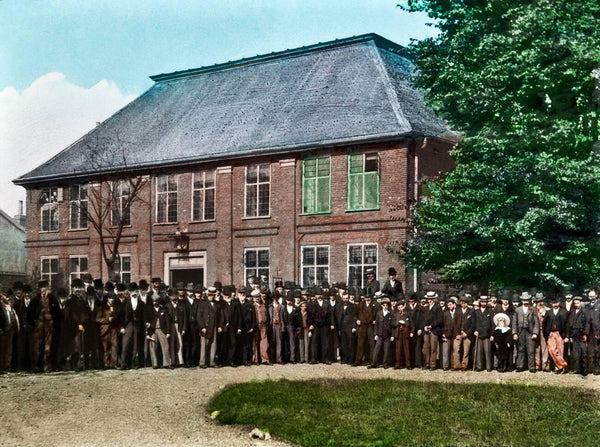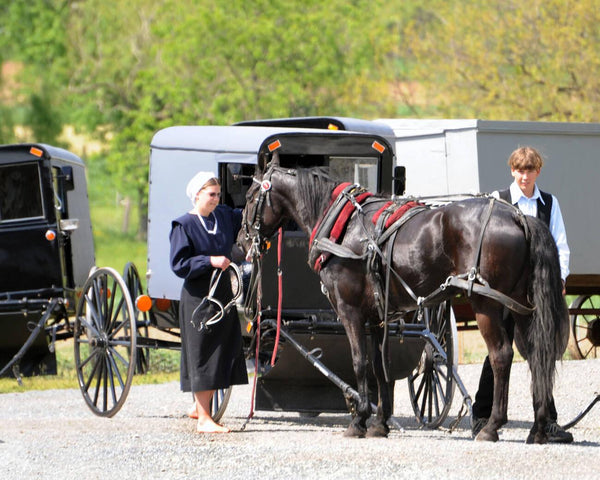The Amish and Quakers are sects of Christianity that have been around for centuries. Both religious groups were formed during the Protestant Reformation that began in the 16th century. During this Reformation, a rebellion broke out against the medieval church as people fought for the right to personal interpretations of the Bible.
Amish and Quakers share similar beliefs in living simple, humble lifestyles and practicing pacifism. Aside from that, these two groups, and the Mennonites, escaped religious persecution in Europe and laid down roots in Pennsylvania in the 1700s. Also, all three believe in non-violence, not taking oaths, and communal living.
However, when we examine their lifestyles and beliefs, significant differences between Quakers and Amish appear. Let’s explore Amish vs Quaker and discuss the key differences between them.
What this article covers:
What’s the Difference between the Amish and Quakers?

The Amish and Quakers arose in the 17th century but are two distinct groups with different interpretations of the Bible, practices, and beliefs. Here’s a breakdown of the primary differences between them.
Difference in Beliefs
At first glance, you might think that the Amish and Quakers adhere to the same beliefs, but this is far from the truth.
Faith
The Amish faith is heavily rooted in scripture and relies on rules to maintain order within their community. All Amish identify as Christians and regard the Bible as the word of God.
On the other hand, Quakers practice “the inner light,” which emphasizes the importance of following one’s conscience and intuition.
Not all Quakers identify as Christians. Some see themselves as members of a universal religion. Although Quakers regard the Bible highly, it is not the only Holy Book that informs their beliefs.
Unlike the Amish, who recite the Dordrecht Confession as their formal creed, Quakers don’t recite any creeds.
Church Hierarchy

The Amish don’t have church buildings and hold services in members’ homes. However, they have a church hierarchy with a bishop, ministers, and a deacon in charge of a church district.
Quakers also don’t have churches and conduct their meetings in meeting houses. However, they don’t believe in the clergy, church hierarchy, or formal liturgy. Believers minister to one another with no defined structure or leader.
Baptism & Communion
You’ll notice a lot of similarities when you look at anabaptist vs Amish. That’s because the Amish are anabaptists and they don’t believe in infant baptism. When the Amish are old enough, they get baptized and can take communion during special communion services held in spring and autumn.
Baptism also differentiates the Amish from other groups. For instance, if you look at Dunkards vs Amish, you’ll see a difference in how they baptize their people. Dunkards practice immersion baptism while Amish baptize by pouring.
That said, Quakers do not believe in ceremonies and do not practice baptism or communion. According to them, everyone can have a direct relationship with God and should do so continually, without rituals or sacraments.
Sermons and Worship

Amish ministers deliver sermons in Pennsylvania Dutch. However, their Bibles are written in high German. Quakers, on the other hand, conduct worship in silence, with members sitting in a circle and waiting for an insight or revelation to share with others.
Differences in Appearance
The Amish must separate themselves from anything that seems worldly. That’s why they have a distinct style of clothing and haircuts. Men wear plain black or dark suits with no decorations, and women wear modest, plain-colored dresses covered with a cape and apron.
Their hair, too, is different from what modern people wear. Men have short hair and long beards with no mustaches. Additionally, women never shave their hair but wear it in a bun and always cover it with a prayer Kapp.

While you can point out a member of the Amish community from the crowd based on their dress style, you can’t point out a Quaker, which is one of the biggest differences between Quakers and Mormons vs Amish. Quakers don’t have a prescribed way of dressing. Quakers don’t restrict their clothing style to anything specific. While their mode of dress is usually not flashy or ostentatious, they don’t have any requirements for their physical appearance; and can wear their hair however they please.
Differences in Lifestyle
Just like beliefs and appearance, the Amish and Quaker lifestyles differ significantly.
Technology
Quakers have fully embraced technology. They use modern tools, such as computers and cell phones, to pursue their business or professional goals. Likewise, Hutterites differ from the Amish in that they have highly industrialized farms.
The Amish, however, live a very traditional lifestyle and keep traditional practices such as owning a bread box. This community is conservative in their approach to technology. This means that they limit the use of modern technologies, such as cars, phones, and electricity.
You’ll often spot people traveling in buggies when you visit Amish country. There are rules governing the color of the buggy, whether the lights must be on, and the speed at which it can travel among different Amish orders.
It’s also pretty easy to differentiate an Amish vs Mennonite buggy based on the color and style. Amish buggies tend to be plain in style.
Education
Formal education lasts till the eighth grade in the Amish community. Members of the community rarely attend modern or public schools, nor do they pursue higher education.
Like the Amish, Quakers have schools for their members, known as Friends schools. Non-Quakers can attend Friends schools as well. Education in these schools emphasizes spirituality, community, and responsibility. These schools focus on nurturing each child’s unique talents, and Quakers are allowed to pursue higher education.
Social and Political Involvement
Amish people avoid involvement in politics. Most Amish orders don’t vote and are not members of any political parties.

On the contrary, Quakers are believers in equality and what better way to express this than actively participating in the political arena? Aside from politics, Quakers also engage in social action projects that promote peace and justice. Their organizations have taken a stand against human trafficking, poverty, climate change, and other human rights abuses.
Quaker Origins vs Amish Origins
The Quakers, or the Religious Society of Friends, and the Amish are two distinct religious groups that have their origins in 17th century Europe. Both groups share a common belief in the importance of living a life guided by faith and simplicity.
The Quakers were founded in England by George Fox and focused on the idea of an inner light that guides individuals to live a spiritual life. They believe in equality among all people, regardless of gender or social class, and reject violence as a means to achieve justice. The Quakers also played a key role in the abolition of slavery and other social reforms.
Are Amish Catholic? No they aren’t. In fact, they formed after a split from the Swiss Brethren in 1693. The founder of the Amish church was Jakob Ammann, a Swiss Anabaptist leader who proposed several changes to the beliefs and practices of the Swiss Brethren, which led to a schism between the Amish Brethren.
Conclusion
The Amish and Quakers have had an important impact on history and continue to influence modern society today through their shared values of faith and simplicity.
Although these groups have many differences, they both have a commitment to living according to their religious beliefs and values.
Did You Find Our Blog Helpful? Then Consider Checking:
- Mennonite vs Amish
- Puritans vs Amish
- Shaker vs Amish
- Amish Seventh-Day Adventists
- Old Order Mennonite vs Amish
- Mennonite vs Amish Clothing
- Why Did the Amish Split from the Mennonites
- Do Amish Pay Taxes
- Do Amish Go to Doctors
- What Do Amish Do for Fun
- How Do the Amish Keep Food Cold
- Do Amish Use Electricity
- Do Amish Use Cell Phones
- Do Amish Drive Cars
- Amish Law
